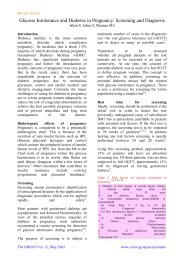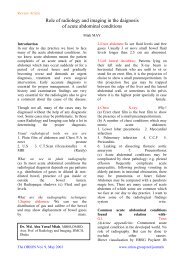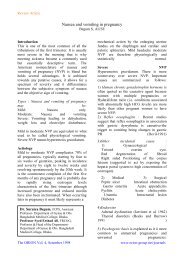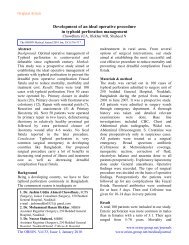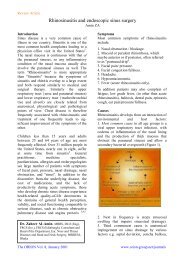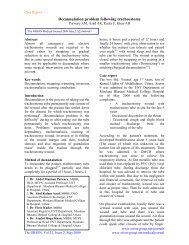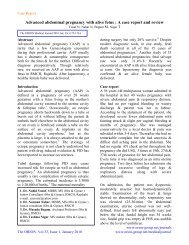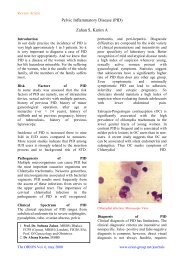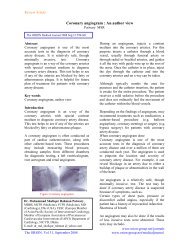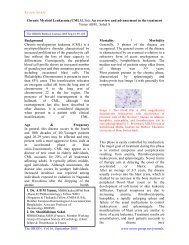PDF - Orion Group
PDF - Orion Group
PDF - Orion Group
You also want an ePaper? Increase the reach of your titles
YUMPU automatically turns print PDFs into web optimized ePapers that Google loves.
Review Article<br />
Children with hymenopetra allergy and its management<br />
Khan AH, Kabir MZ<br />
The ORION Medical Journal 2004 Sep;20:246-247<br />
About 75% of world’s animal species are<br />
arthropods. Most of them usually have no<br />
interaction with humans, but a small number of<br />
medically detrimental species which possess<br />
venom can cause morbidity and mortality when<br />
humans are bitten or stung.<br />
Most important venomous arthropods are 12<br />
(i) The arachnids (spider, scorpions)<br />
(ii) Insects of the order Hymenopetra (Parasitic<br />
or social) includes (a) bees, (b) yellow jackets<br />
(c) Hornets (d) Other wasps (e) stinging ants.<br />
These species inject venom during bite by fang<br />
or sting.<br />
Bite describes venom injected via structures<br />
associated with the mouth such as fangs or<br />
mandibles and sting means the injection of<br />
venom via a tapered posterior structure most<br />
accurately called a sting.<br />
Insects of the order Hymenopetra are largest in<br />
number and are the most important venomous<br />
arthropods.<br />
Hymenopetra<br />
The hymenopetra get their name from the Greek<br />
words hymen and pteron, meaning membrane<br />
and wing, respectively and this gives the first<br />
clue to identify them 9 .<br />
Hymenopetra stings allergies have been<br />
recognized as a world wide health hazard.<br />
Anaphylactic reactions caused by hymenopetra<br />
1. Dr, Anwar Hossain Khan, MBBS, FCPS<br />
(Ped), MD (Ped. Nephrology) Associate Prof.<br />
Pediatris Nephrology, National Institute of<br />
Kidney Diseases & Urology (NIKDU)<br />
2. Prof. Md. Zahangir Kabir, MBBS,<br />
FCPS (Med), FCW (Nephro) UK. Professor of<br />
Nephrology & Director NIKDU.<br />
sting predominantly bee, wasp, paper wasp<br />
stings are common medical problem.<br />
The first documented anaphylactic reaction of<br />
hymenopetra sting was the death of the<br />
Egyptians pharaohmens who died according to<br />
an Egyptian hieroglyph in the year 2640 BC due<br />
to a wasp sting 1 . Except some social forms<br />
exhibit extremely fierce defense of their nest,<br />
most wasp and bees are solitary and do not<br />
defend their nests, though they will sting in<br />
defense if caught. Only a few social species<br />
have sufficiently venomous stings to be of<br />
medical significance, eg honey bees and bamble<br />
bees. It is the social hymenopetra that actively<br />
defend their nest and it is mostly these groups<br />
that cause medically significant stings. Among<br />
the ants all are social but only a few species do<br />
have medically significant stings eg fire ants.<br />
Children’s involved in outdoor activities and<br />
sports are vulnerable to hymenopetra stings. In<br />
our country naughty children either disturb the<br />
nest of social hymenopetra or accidentally come<br />
under attack of disturbed hymenopetra & get<br />
medically significant stings.<br />
Components of hymenopetra venoms<br />
During the course of evolution the stinging<br />
insects develop venoms an injectable mixture of<br />
amines peptides and enzymes which are capable<br />
of disrupting a wide range of cell mechanisms.<br />
In addition to Histamine, serotonin,<br />
acetylcholine, kinins, protein enzymes like<br />
phospholipase A, hyaluronidases are present in<br />
the venom. These two enzymes are responsible<br />
for majority of allergic reactions 2 .<br />
Honey Bee venom 12<br />
Contains Enzymes, smaller proteins, peptides<br />
and amines.<br />
a. Melittin (50% of venom dry weight) it<br />
hydrolyzes cell membranes causing changes in<br />
The ORION Vol. 20 January 2005<br />
www.orion-group.net/journals
Review Article<br />
permeability and is most responsible for the<br />
pain associated with the sting.<br />
b. Peptide 401: Mast cell degranulating peptide,<br />
cause, release of histamine and setting up an<br />
inflammatory reaction.<br />
c. Enzymes: include phosphopatase A2: It is the<br />
major venom allergen and is responsible for<br />
inducing IgE mediated anaplylaxis and it in<br />
concert with melittin is a major hemolytic<br />
factor.<br />
d. Hyaluronidase : major spreading factor.<br />
e. Physiologically active amines are histamine,<br />
dopamine, nor-epinephrine.<br />
Wasp venom contains 12<br />
Wasp comprises the largest number in the order<br />
hymenopetra and their venoms has low<br />
mammalian toxicity and it contains enzymes,<br />
smaller peptides and amines<br />
a. Enzymes: Phospholipases, hyaluronidases,<br />
cholinesterasesthese are principally responsible<br />
for allergic responses of wasp venoms.<br />
b. Peptides: mastoparans which cause histamine<br />
& serotonin release by degranulating mast cells.<br />
c. Amines like histamine, serotonin with<br />
acetycholine affect neurons and contribute to the<br />
pain of these sting.<br />
Ant venoms 12<br />
Most critical component of fire ant venom are<br />
alkaloid (methyl m piperidines) which inhibit<br />
Na+K+ATPase pump of muscle cells membrane<br />
resulting in post synaptic blockade. Damage is<br />
expressed in hemolytic, cytotoxic and serologic<br />
reactions. Anaphylactic reaction may occur due<br />
to allergenic proteins.<br />
Reactions to venoms<br />
The most common reaction following<br />
hymenopetra sting is a painful wheal or hive<br />
caused by the venom. The site rapidly become<br />
pruritic and itching can last for several hours<br />
(possibly due to IgE mediated response).<br />
Venoms contain a variety of neurotoxins,<br />
including, small ring like peptides that insert<br />
themselves in cell membranes and causes<br />
depolarisaton of nerve cells and consequently<br />
pain 9 . The most feared IgE mediated response is<br />
of course anaphylaxis. Cross linking of venom<br />
antigens to previously found lgE antibodies on<br />
basophil surfaces, releases multiple. Preformed<br />
mediators that leads to a cascade of<br />
pathophysiologic responses the best known of<br />
these mediators is histamine the clinical<br />
menifestation of histamine effect include.<br />
a. Diffuse urticaria d. Laryngealoedema<br />
b. Bronchospasm e. Nausea, vomiting<br />
c. Laryngospasm f. Hypotension<br />
The onset of action is rapid usually within<br />
minutes of a sting though in rare cases it can be<br />
delayed for several hours.<br />
Delayed effects such as serum sickness,<br />
peripheral neuritis or nephrosis are probably<br />
related to antigen antibody reaction (immune<br />
complex deposition)<br />
Most fatalities from bee and wasp stings occur<br />
in hypersensitive individuals; death most often<br />
induced by a single sting and occurs most often<br />
within an hour after the sting. Most deaths are<br />
caused by:<br />
1. Respiratory dysfunction<br />
2. Anaphylaxis.<br />
Large number of bee stings can also cause death<br />
in non hypersensitive individuals. Patients may<br />
present with acute renal failure 7 .<br />
Clinical aspects 2<br />
Reactions to venom usually occurs in atopic<br />
than in non atopic subjects. There is always<br />
some local reaction to a sting and in some cases<br />
a very marked and persistent local effects<br />
heralds a more generalized reaction to<br />
subsecuent stings within 30 minutes, pruritus<br />
The ORION Vol. 20 January 2005<br />
www.orion-group.net/journals
Review Article<br />
and urticaria, faintness and hypotension,<br />
respiratory difficulty, nausea, vomiting, diarrhea<br />
can occur even cardiac arrythmias have been<br />
noted in children below the age of 10 years &<br />
can die from sting anaphylaxis.<br />
Apart from classical anaphylaxis, a number of<br />
other types of reaction have been described,<br />
including a reaction resembling serum sickness<br />
with joint pains and fever developing after some<br />
days and persisting for some weeks.<br />
• Proteinuria is common but usually short lived.<br />
• Hematuria is also recognized.<br />
• Vesicular skin eruption of delayed onset.<br />
• Peripheral neuropathy.<br />
• Intracranial hemorrhage or oedema.<br />
• Mental changes<br />
• Acute renal failure may also occur 5<br />
According to Mueller 8 . Sign and symptoms are<br />
classified in different grades.<br />
Grade l: Urticaria, Pruritus, Malaise.<br />
Grade Il: Angioedema, Chest Tightness,<br />
Nausea, Vomiting, Abdominal Pain, Dizziness.<br />
Grade III: Dyspnoea, Wheeze, Stridor,<br />
Dysphagia, Hoarseness.<br />
Grade IV: Hypotension, Collapse, loss of<br />
consciousness, Incontinence, Cyanosis.<br />
Management of hymenopetra sting<br />
1. Avoidance of behaviour to lower the risk of<br />
resting.<br />
2. Injectable or oral antihistamine to reduce the<br />
peripheral symptoms such as urticaria.<br />
3. Injectable corticosteroid: The efficient drug<br />
for prevention of anaphylaxis.<br />
4. Injection: Epinephrine for acute emergency<br />
medication in case of severe anaphylaxis<br />
5. Referral to the allergy specialist for<br />
evaluation for venom immunotherapy.<br />
Emergency treatment of choice is still 0.5 ml of<br />
1 in 1000 solution of Epinephrine given by deep<br />
s/c Injection and repeated in 10 minutes if<br />
necessary. Failing this a pressurized atomizer<br />
containing isoprenaline or Epinephrine can be of<br />
value 2 .<br />
Antihistamins and corticosteroids provide no<br />
immediate benefit but can undoubtedly mitigate<br />
the later symptoms and speed recovery. Above<br />
mentioned drug can be used alone or in<br />
combination like:<br />
1. Antihistamine, Corticosteroid and<br />
epinephrine alone.<br />
a. Antihistamine & Corticosteroid.<br />
b. Epinephrine & Antihistamine.<br />
c. Epinephrine, Antihistamine & Corticosteroid.<br />
Immunothrapy: It is safe and effective therapy<br />
and constitute an adequate model for the study<br />
of immunological changes occurring in the short<br />
and long term and for understanding the<br />
mechanism of action of venom 15 .<br />
(A) Rush SIT 6<br />
Is a reliable method for the treatment of<br />
anaphylactic reaction to hymenopetra venom<br />
even in less developed countries. Specific<br />
immunotherapy is done in hospitalized patient<br />
after getting complete history (age, sex, age<br />
when sting reaction happened, time of stinging,<br />
place of stings and symptoms after sting<br />
episode) Immunotherapy starts with single<br />
venom type by subcutaneous route. (first at 4th<br />
day then after 7 day, 14 day and monthly for a<br />
period of 3 years).<br />
Efficacy of rush SIT is well documented 13<br />
It enables a hospital controlled administration of<br />
venom with a success of more them 95 % cases.<br />
Adverse reactions of different grades including<br />
anaplylacitc reactions have been reported up to<br />
64% cases 11 .<br />
Venom Immunotherapy (VIT) 3<br />
Patient having systemic reaction to hymenopetra<br />
sting should be evaluated by allergy specialist<br />
The ORION Vol. 20 January 2005<br />
www.orion-group.net/journals
Review Article<br />
for the VIT. This involves a gradual weekly<br />
then biweekly increase in venom dose over 6-20<br />
weeks, until a maintenance dose is reached.<br />
After that periodic booster dose administered at<br />
4-8 week interval for a period of 3 to 5 years.<br />
The individual response depend on the rise of<br />
lgG the blocking antibody and an offsetting<br />
decrease in IgE. The risk of anaphylaxis from<br />
VII is minimal (0.17%) per year and no reported<br />
deaths but local reaction can occur is 50% of<br />
patients.<br />
Efficacy: Mixed vespid venom has higher<br />
efficacy then Individual one & VIT effective in<br />
97% of cases.<br />
Prognosis: Recurrence risk declines with time a.<br />
Initially 50%, b. By year 3-5:35%, c. By year<br />
10:25%<br />
References<br />
1. CohenSG: Thepharaohandthewasp.<br />
Allergyproc 1989,10: 149.151).<br />
2. Frankland AW, Lessol MH: Allergy to bee<br />
sting : A review : Journal of Royal society of<br />
medicine Vol 73 Nov 1980 P: 807.<br />
3. Graff LG: Insect sting anapbylaxis and<br />
hymenopetra venom Immunotherapy physician<br />
information : Internet<br />
4. Golden DB, schwartz Hi: Guidelines for<br />
venom immunotherapy. I Allergy din immunol<br />
1986, 77: 727-728.<br />
5. Humblet Y, Sonnet J, VAN Ypersele DE<br />
Sirihou C. Bee stings and acute tubular necrosis<br />
(letter). Nephron. 1982,31:187-8<br />
6. Mingomataj E et al: Specific<br />
immunotherapy in Albanian Patients with<br />
anaphylaxis to hymenopetra venom’s. BMc<br />
Dermatol :2000 : 2(1):11.<br />
7. Mejia et al: acute reanal failure due to<br />
multaple stings by Africanzed bees annales of<br />
mt medicine: vol 104: No 2 Feb:1986: P 210-11.<br />
8. Mueller HI: Insect allergy. Pediatr clinic<br />
North Am 1959: 6: 59-64.<br />
9. Quicke DI: Hymenopetra : In ‘Encylopedia<br />
of insects,’ Resh V and cardi R. editors, PP 534-<br />
539 Elstvie’r 2003.<br />
10. Reisman RE, Livingston A: Late-onset<br />
allergic reactions , including serum sickness,<br />
a’ter insect stings. JAllergyClin immunol 1989,<br />
84:331-337.<br />
11. Reisman RE, Livingston k venom<br />
immunotherapy: 10 years of experience with<br />
administration of single venoms and 50<br />
micrograms maintenance doses. I Allergy<br />
Clinimmunol 1992,89: 1189. 1195.<br />
12. Vetter RS and visscher PK: Bits and sting<br />
of medically important venomous arthropods<br />
International journal of Dermatotogy 1998 vol<br />
37 P 481-496).<br />
13. Valentine M, Schuberth K Sobotka A, Graft<br />
D, Kwiterovich K, Szklo M, Lichtenstein I:<br />
14. The value of immunotherapy with venom in<br />
children with allergy to insect stings. N EngI J<br />
Med 1990,323: 1601- 1603.<br />
15. Moreno C : Hymenopetra allergy : the need<br />
not to stop : Allergol, Immunol clinic 2000: 15 :<br />
353-354.<br />
The ORION Vol. 20 January 2005<br />
www.orion-group.net/journals



